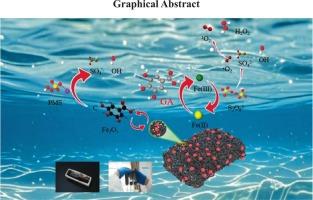含油污泥碳基材料与没食子酸对过氧单硫酸盐活化增强对硝基苯酚的降解
IF 4.3
2区 工程技术
Q2 ENGINEERING, CHEMICAL
引用次数: 0
摘要
石油圈含油污泥的处理和处置给资源节约和环境保护带来了严重的障碍。通过热解将含油污泥转化为碳基材料,对其表面结构和晶体形成进行了研究。与不含没食子酸(GA)的体系相比,GA辅助体系显著提高了osc -800活化的过氧单硫酸盐(PMS)对对硝基苯酚(PNP)的降解效率。在GA浓度为0.25 mM时观察到最佳的催化降解效率,在100 min内实现了88.14 %的PNP降解。反应速率常数(Kobs)提高了2.42倍,COD去除率提高了1.65倍,过氧单硫酸钾利用率提高了2.90倍。在OSC-800/GA/PMS系统中,确定了影响GA增强机制的两个关键因素。首先,GA使Fe(II)/Fe(III)在催化剂表面的氧化还原循环更加容易,从而提高了PNP降解活性基团的生成。其次,GA加速了电子传递,提高了反应速率。该研究为利用还原剂提高碳基材料对硫酸双氢盐的活化提供了一种新的方法。本文章由计算机程序翻译,如有差异,请以英文原文为准。


Oily sludge carbon-based materials with gallic acid towards peroxymonosulfate activation for enhancing the degradation of p-nitrophenol
The petroleum sphere’s handling and disposal of oily sludge presents serious obstacles to resource conservation and environmental preservation. Oily sludge (OS) was converted into carbon-based materials through pyrolysis, and their surface structure and crystal formation were investigated. Compared with systems without gallic acid (GA), the GA-assisted system significantly enhanced the degradation efficiency of p-nitrophenol (PNP) by OSC-800-activated peroxymonosulfate (PMS). The optimal catalytic degradation efficiency was observed at a GA concentration of 0.25 mM, achieving an 88.14 % degradation of PNP within 100 min. The observed reaction rate constants (Kobs) increased by 2.42 times, the removal rate of COD improved by 1.65 times, and the utilization rate of potassium peroxymonosulfate rose by 2.90 times. Two key factors were identified that contributed to enhancement mechanism of GA in the OSC-800/GA/PMS system. Firstly, The Fe(II)/Fe(III) redox cycle on the catalyst’s surface was made easier by GA, which improved the production of active groups for PNP degradation. Secondly, GA sped up electron transfer, which increased the reaction rate. The study offers a novel method for employing reductants to improve the activation of permonosulfate by carbon-based materials.
求助全文
通过发布文献求助,成功后即可免费获取论文全文。
去求助
来源期刊

Chemical Engineering Science
工程技术-工程:化工
CiteScore
7.50
自引率
8.50%
发文量
1025
审稿时长
50 days
期刊介绍:
Chemical engineering enables the transformation of natural resources and energy into useful products for society. It draws on and applies natural sciences, mathematics and economics, and has developed fundamental engineering science that underpins the discipline.
Chemical Engineering Science (CES) has been publishing papers on the fundamentals of chemical engineering since 1951. CES is the platform where the most significant advances in the discipline have ever since been published. Chemical Engineering Science has accompanied and sustained chemical engineering through its development into the vibrant and broad scientific discipline it is today.
 求助内容:
求助内容: 应助结果提醒方式:
应助结果提醒方式:


